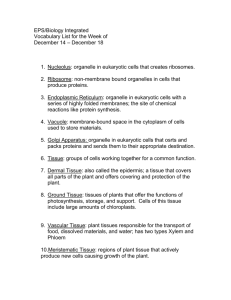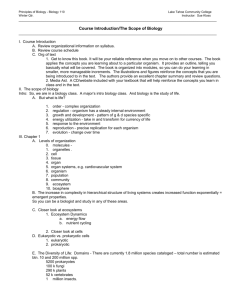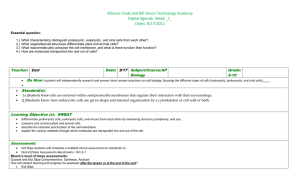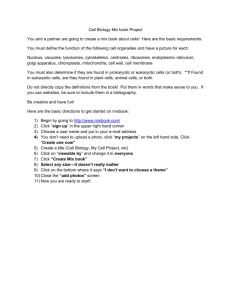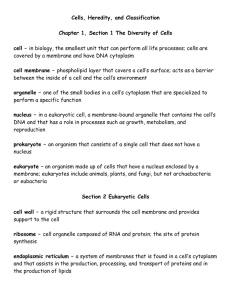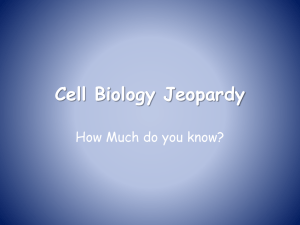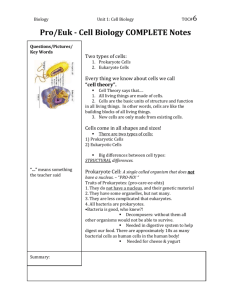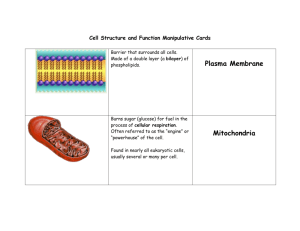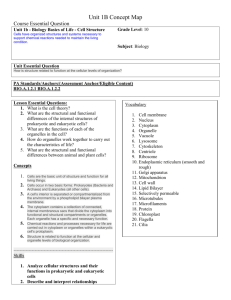The Cell
advertisement
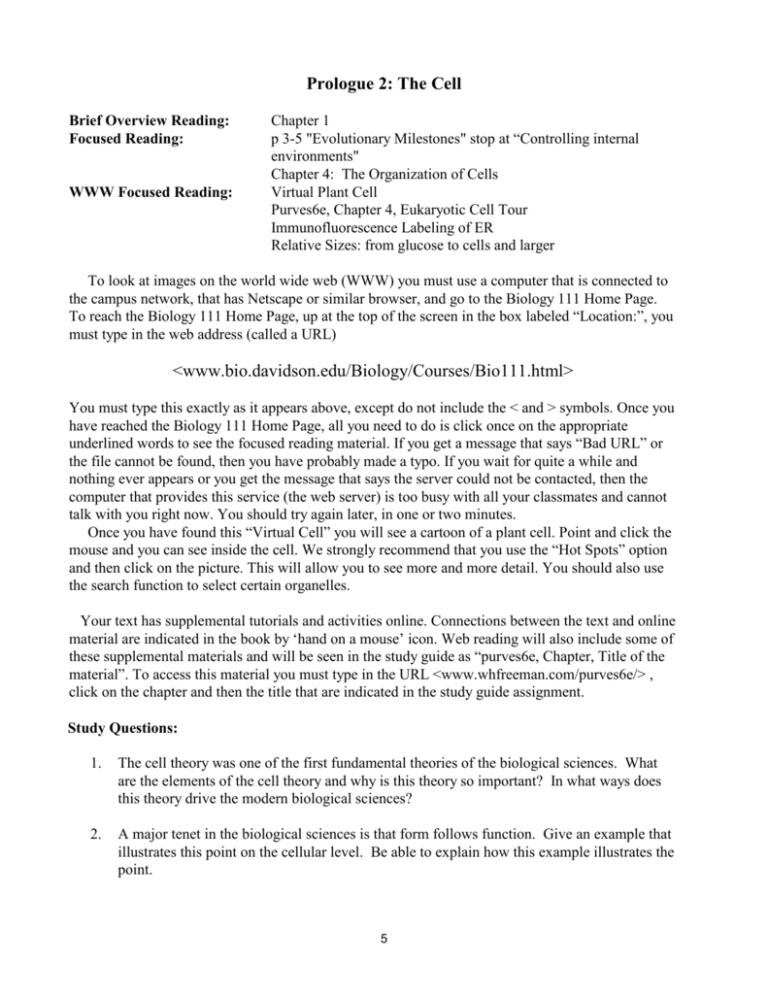
Prologue 2: The Cell Brief Overview Reading: Focused Reading: WWW Focused Reading: Chapter 1 p 3-5 "Evolutionary Milestones" stop at “Controlling internal environments" Chapter 4: The Organization of Cells Virtual Plant Cell Purves6e, Chapter 4, Eukaryotic Cell Tour Immunofluorescence Labeling of ER Relative Sizes: from glucose to cells and larger To look at images on the world wide web (WWW) you must use a computer that is connected to the campus network, that has Netscape or similar browser, and go to the Biology 111 Home Page. To reach the Biology 111 Home Page, up at the top of the screen in the box labeled “Location:”, you must type in the web address (called a URL) <www.bio.davidson.edu/Biology/Courses/Bio111.html> You must type this exactly as it appears above, except do not include the < and > symbols. Once you have reached the Biology 111 Home Page, all you need to do is click once on the appropriate underlined words to see the focused reading material. If you get a message that says “Bad URL” or the file cannot be found, then you have probably made a typo. If you wait for quite a while and nothing ever appears or you get the message that says the server could not be contacted, then the computer that provides this service (the web server) is too busy with all your classmates and cannot talk with you right now. You should try again later, in one or two minutes. Once you have found this “Virtual Cell” you will see a cartoon of a plant cell. Point and click the mouse and you can see inside the cell. We strongly recommend that you use the “Hot Spots” option and then click on the picture. This will allow you to see more and more detail. You should also use the search function to select certain organelles. Your text has supplemental tutorials and activities online. Connections between the text and online material are indicated in the book by ‘hand on a mouse’ icon. Web reading will also include some of these supplemental materials and will be seen in the study guide as “purves6e, Chapter, Title of the material”. To access this material you must type in the URL <www.whfreeman.com/purves6e/> , click on the chapter and then the title that are indicated in the study guide assignment. Study Questions: 1. The cell theory was one of the first fundamental theories of the biological sciences. What are the elements of the cell theory and why is this theory so important? In what ways does this theory drive the modern biological sciences? 2. A major tenet in the biological sciences is that form follows function. Give an example that illustrates this point on the cellular level. Be able to explain how this example illustrates the point. 5 3. What are the differences between prokaryotes and eukaryotes? Give an example of each type of cell. 4. Approximately how big are typical prokaryotic and eukaryotic cells? About how big is this? What else is this size? How much smaller is a cell than say a marble or a bowling ball or a typed period -- "."? What are the limiting factors in cell size (i.e. why can't cells be larger than they are? Why aren't they smaller?) 5. Eukaryotic cells are full of little compartments called organelles. Why? What is adaptive or useful about having all these little compartments? 6. For each organelle or cellular structure described in Chapter 4 A. Be able to give a very brief (a few words) description of its basic function(s). B. Be able to draw and label each organelle or accurately describe its structure. Pay close attention to the distinguishing features of the organelle (e.g. the curved, stacked cisternae of the Golgi apparatus, the small and large subunit structure of the ribosome, the double membrane surrounding the nucleus, the microtubular core of the cilia and flagella, etc.) (Study note: Online supplement includes ‘flashcards’ for each chapter that are good for definitions.) 7. Today’s reading includes two animations of the ‘same’ content. Compare Virtual Plant Cell and Purves6e, Chapter 4, Eukaryotic Cell Tour. What are the strong and weak points of each? 8. Be able to describe or make a sketch of the structures of a chloroplast, a mitochondrion, a nucleus. Occasionally, there will be places in the study guide where you will find fact-oids called “News Items”. The information in these news items is not for you memorize, nor will it be tested. However, you might find them very interesting since they contain recent research findings based on the material you are learning. For example: News Item: Researchers recently identified a giant sulfur bacterium, which they called Thiomargarita namibiensis. This organism is remarkable because it is a prokaryote but the cells grow to have diameters of 750 m (see "Relative Size' website for illustration of how big, or small, this is). While this is still very small when compared to a house, prokaryotes have no internal membrane systems and so the exchange of nutrients and waste products must occur by diffusion. According to previous thought a prokaryotic cell this large is not possible--but there it is off the coast of Chile. How can this organism survive? You can't change the laws of nature so does it use mechanisms we haven't seen before? Since this organism was only discovered recently much more work must be done to answer questions like these. For more information see H.N. Shulz et al. 1999 Science. Vol 284 p493-5 -------------------------------------------------------------------STOP------------------------------------------------------------------------------ 6

